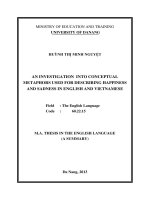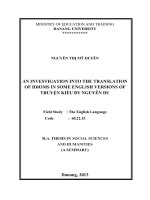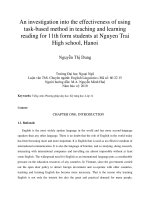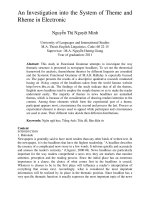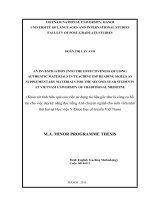An investigation into conceptual metaphors of fire in american and vietnamese 20th century poetry
Bạn đang xem bản rút gọn của tài liệu. Xem và tải ngay bản đầy đủ của tài liệu tại đây (561.71 KB, 26 trang )
MINISTRY OF EDUCATION AND TRAINING
UNIVERSITY OF DANANG
BÙI THỊ KIM PHỤNG
AN INVESTIGATION INTO CONCEPTUAL
METAPHORS OF “FIRE” IN AMERICAN
AND VIETNAMESE 20th CENTURY POETRY
Major: THE ENGLISH LANGUAGE
Code: 60.22.15
MASTER THESIS IN SOCIAL SCIENCES
AND HUMANITIES
(A SUMMARY)
Danang, 2014
The study has been completed at
the College of Foreign Languages, University of Danang
Supervisor: Assoc. Prof. Dr. LƯU QUÝ KHƯƠNG
Examiner 1: Hồ Thị Kiều Oanh, Ph. D.
Examiner 2: Nguyễn Quang Ngoạn, Ph. D.
The thesis will be presented to the dissertation board
Time
: 14th June, 2014
Venue : University of Danang
The thesis is accessible for the purpose of reference at:
- Library of the College of Foreign Language, Danang University
- Information Resources Centre, Danang University
1
CHAPTER 1
INTRODUCTION
1.1. RATIONALE
In the ground-breaking work Metaphors We Live By (1980)
Lakoff and Johnson showed that metaphor is a fundamental,
structuring mechanism in the way we interact with and perceive the
world around us and a common and easily accessible linguistic
phenomenon that we often do not notice is in fact a metaphor. In
daily life, we are ruled not only by our understanding but also our
perception.
Metaphor has universality as well as variation characteristics.
Unrelated languages can share the same metaphor. However, there
remains differences in the range of conceptual metaphors that
languages and cultures have available for the conceptualization of
particular domains due to the cultural heritages.
Fire plays an important role in the formation and evolution of
the universe. It has been a part of our planet from its inception, along
with water, air, and earth. Fire is considered as a vivid cultural
symbol: “an element which operates in the center of all things”. The
significance of fire can be demonstrated by the numerous stories
about fire in mythology, religion as well as literature. For example:
In American:
The warm bodies
shine together
2
in the darkness
the hand moves
of the flesh,
the skin trembles
in happiness
and the soul comes
joyful to the eyes.
(Allen Ginsberg, Song)
In Vietnamese:
Anh chạm vào em
Đá chạm vào đá…..
Từ em những đốm lửa ra đời
Mang sức cháy của anh trong cốt tủy.
(Trần Nhuận Minh, Đá cháy)
Fire appears as the result of the friction of two flints like heat is
created by the friction of two bodies. There is connection between
the concept of fire and the concept of sexuality from the examples
above. The poets used the image of fire to talk about sexuality.
3
“Fire” appears in many poems in both American and
Vietnamese 20th century poetry. However, most of students of
English, including Vietnamese students find hard to deeply realize
and analyze what exist behind the words denoting fire in these cases.
Therefore, the research entitled: “An Investigation into Conceptual
Metaphors of “Fire” in American and Vietnamese 20th Century
Poetry” was conducted.
1.2.
AIMS AND OBJECTIVES
1.2.1.
Aims
This study is aimed to clearly identify the conceptual
metaphors of “fire” in American and Vietnamese 20th century poetry,
similarities and differences in linguistic and cultural features of fire
through its conceptual metaphors used in the poetry of the two
countries; then we can apply to teaching and learning English
language poetry.
1.2.2.
-
Objectives
to analyze conceptual metaphors of “fire” in American and
Vietnamese 20th century poetry.
-
to find out similarities and differences between conceptual
metaphors of “fire” in American and Vietnamese 20th century
poetry.
-
to present suggestions for English teaching and learning about
conceptual metaphors of “fire” in the 20th century poetry in English
and Vietnamese languages in particular, in English and Vietnamese
languages in general.
1.3. SIGNIFICANCE OF THE STUDY
4
This research is hoped to be a practical work and will be a
good reference for further studies about conceptual metaphors. It can
help learners and teachers have a good understanding about how fire
is metaphorically conceptualized in American and Vietnamese 20th
century poetry.
1.4. RESEARCH QUESTIONS
1. What are the conceptual metaphors of “fire” in American and
Vietnamese 20th century poetry?
2. What are the similarities and differences between conceptual
metaphors of “fire” in American and Vietnamese 20th century
poetry?
1.5. SCOPE OF THE STUDY
The study mainly focused on the findings of conceptual
metaphors of “fire” in American and Vietnamese 20th century poetry.
1.6.
ORGANIZATION OF THE STUDY
Chapter 1: Introduction
Chapter 2: Literature Review and Theoretical Background
Chapter 3: Research Design and Methodology
Chapter 4: Findings and Discussions
Chapter 5: Conclusion and Implications
5
CHAPTER 2
LITERATURE REVIEW
AND THEORETICAL BACKGROUND
2.1. PREVIOUS STUDIES RELATED TO THE RESEARCH
Lakoff and Johnson (1980) claimed that metaphor is not just
a matter of language, but it governs our ordinary conceptual system.
Since then, research on metaphor has headed towards a new
direction. In recent years, conceptual metaphor has occupied an
important position in discussions within the field of cognitive
linguistics: Gibbs (1994) with “The Poetics of Mind”, Kövecses
(2002), (2005) with Metaphor: “A Practical Introduction” and
“Metaphor in Culture” respectively.
In Vietnam, Lý Toàn Thắng (2005) mentioned the history of
cognitive linguistics and the differences in the world image from
different cultures. Nguyễn Thị Tú Trinh (2011) investigated the
linguistic features of conceptual metaphors of three concepts: “life”,
“death” and “time”. Trần Nữ Thảo Quỳnh (2013) focused on the
conceptual metaphors Expressing Love and Hatred, etc.
2.2. THEORETICAL BACKGROUND
2.2.1. Cognitive Semantics
a. Definition of Cognitive Semantics
Cognitive semantics is defined as the study of the relationship
between experience, embodied cognition and language.
b. Tenets of Cognitive Linguistics
Gardenfors presented cognitive semantics in six tenets:
6
1.
Meaning is conceptualization in a cognitive model.
2.
Cognitive models are mainly perceptual determined.
3.
Semantic elements are based on spatial or topological objects.
4.
Cognitive models are primarily imaged-schematic.
5.
Semantics is primary to syntax and partly determines it.
6.
Concepts show prototype effects.
2.2.2. Metaphor
a. Traditional Theories of Metaphor
Generally, there are two main approaches in the study of
metaphor: the traditional approach, which includes many different
theories but shares some
fundamental presumptions, and the
cognitive approach, which, despite being very recent, has become the
most influential theory of metaphor.
b. Conceptual Metaphor
In the cognitive linguistic view, metaphor is defined as
understanding one conceptual domain in terms of another conceptual
domain. We can set the formula for this view of metaphor that
CONCEPTUAL DOMAIN A IS CONCEPTUAL DOMAIN B,
which is called a conceptual metaphor.
The conceptual domain from which we draw metaphorical
expressions to understand another conceptual domain is called the
source domain, while the conceptual domain that is understood this
way is the target domain.
2.2.3. Metaphoric Mappings
Conceptual domain A can be understood by conceptual
domain B because there is a set of correspondences or inter-domain
mappings of concepts between them. The linguistic expressions used
7
metaphorically
must
conform
to
established
mappings,
or
correspondences, between the source and the target.
2.2.4. Classification of Conceptual Metaphor
a. Structural Metaphor
The cognitive function of these metaphors is to enable
speakers to understand target A by the structure of source B.
b. Ontological Metaphor
Ontological metaphors can be understood as entity and
substance metaphors.
c. Orientational Metaphor
Orientational metaphors utilize spatial images such as whole,
center, link, balance, in, goal, and front as positive, while their
opposites, not whole, periphery, no link, imbalance, out, no goal, and
back are seen as negative.
d. Conduit Metaphor
With conduit metaphor, ideas are represented as objects, words
as containers, and communication as sending the ideas in the words,
so that the addresser may get the ideas out of the words.
2.2.5. Metaphor in Literature
Lakoff and Turner (1989) claimed that the metaphorical
expressions produced by prestigious poets can often be seen as novel
uses of the conventional conceptual metaphors that also underlie
much of our everyday metaphorical language.
Kövecses (2002) mentioned the relationship between the
metaphors used in ordinary language and those used in literature,
including poetry.
2.2.6. Fire
8
a. Definition of Fire
Hornby (2005) claimed six distinguished definitions of “fire”:
(1) the flames, light and heat, and often smoke, that are produced
when something burns; (2) flames that are out of control and destroy
buildings, trees, etc. (3) a pile of burning fuel, such as wood or coal,
used for cooking food or heating a room; (4) a piece of equipment
for heating a room; (5) shots from guns; (6) very strong emotion,
especially anger or enthusiasm.
b. Fire in Culture
According Chevalier and Gheerbrant (1996), fire has been a
mystical and religious symbol of great significance for cultures
throughout the world. Different cultures share the similarities and
also differences in their belief and thought of fire. These similarities
and differences can affect the way people communicate and therefore
create various meanings of the notion “fire”.
9
CHAPTER 3
RESEARCH DESIGN AND METHODOLOGY
3.1. RESEARCH METHODS
This paper chooses the descriptive, contrastive, quantitative and
qualitative approaches throughout the study.
3.2. DESCRIPTION OF SAMPLES
In this study, 600 samples of conceptual metaphors of “fire” are
collected from American and Vietnamese 20th century poems from
the Internet, books, and press.
3.3.
DATA COLLECTION
All of them are picked out from a lot of poems on different
websites, books, and press.
3.4. DATA ANALYSIS
- Describing qualitatively and quantitatively the data collected
- Analyzing the linguistic features of conceptual metaphors of “fire”
based on the schemas of conceptual mappings in the two languages
- Classifying the conceptual metaphors of “fire” in American and
Vietnamese 20th century poetry
- Pointing out the similarities and differences between conceptual
metaphors of “fire” in American and Vietnamese 20th century
poetry
3.5. INSTRUMENTS
10
We use Microsoft Word and Foxit Reader softwares for
searching the frequency lists of words denoting “fire” in English and
Vietnamese.
3.6. RESEARCH PROCEDURES
-
Reviewing the previous studies thoroughly and identifying the
research scope
-
Collecting American and Vietnamese 20th century poems from
books, press and the Internet
-
Picking out 600 metaphorical expressions of “fire” from
American and Vietnamese 20th century poems for investigation
-
Identifying the conceptual metaphors of “fire” used in the poems
-
Analyzing and presenting data by using the tables and diagrams
-
Withdrawing the similarities and differences in metaphors of
“fire” in American and Vietnamese 20th century poetry
-
Discussing the findings and suggesting some implications for
teaching and learning American and Vietnamese poetry.
3.6. RELIABILITY AND VALIDITY
The data collection is based on poems that are written by
native speakers of American and Vietnamese in the 20th century. The
samples are extracted from reliable websites, books, and printings.
The data ensure to include variants in each language thanks to the
use of descriptive, qualitative and quantitative methods.
11
CHAPTER 4
FINDINGS AND DISCUSSION
4.1. CONCEPTUAL METAPHORS OF “FIRE”
4.1.1. Metaphoric Mappings of Conceptual Metaphors of
“Fire”
4.1.2. Conceptual Metaphors of “Fire” in American and
Vietnamese 20th Century Poetry
Table 4.1. A Summary of Conceptual Metaphors of “Fire” in
American and Vietnamese 20th Century Poetry
CONCEPTUAL METAPHORS OF FIRE
-
DESIRE (SEXUAL DESIRE, AMBITION, CURIOSTY)
-
A CONTAINER
-
A PLANT
-
A PERSON ( A WOMAN, HEART)
-
AN OBJECT
-
MUSIC
-
SOUL
-
A TRANSPORT
12
-
AWARENESS
-
A HUNGRY ANIMAL
-
ILLNESS
-
GLORY
-
THOUGHT
-
REGENERATION
-
DESTRUCTION
-
CONFLICT
4.2. SIMILARITIES AND DIFFERENCES IN CONCEPTUAL
METAPHORS
OF
“FIRE”
IN
AMERICAN
AND
th
VIETNAMESE 20 CENTURY POETRY
Table 4.2. Frequency of Conceptual Metaphors of “Fire” in
American and Vietnamese 20th Century Poetry
American
Vietnamese
Source Domains
Occurrence
%
Occurrence
%
1
DESIRE
56
18.54
52
17.51
2
A CONTAINER
28
9.27
18
6.06
3
A PLANT
9
2.98
13
4.38
13
4
A PERSON
30
9.93
26
8.75
5
AN OBJECT
15
4.97
19
6.40
6
MUSIC
0
0
6
2.02
7
SOUL
21
6.95
22
8.42
8
A TRANSPORT
9
2.98
15
5.05
9
AWARENESS
10
3.31
17
5.72
15
4.97
0
0
10
A HUNGRY
ANIMAL
11
ILLNESS
22
7.28
16
5.39
12
GLORY
11
3.64
12
4.04
13
THOUGHT
5
1.66
3
1.01
14
REGENERATION
12
3.97
14
4.71
15
DESTRUCTION
31
10.26
28
9.43
16
CONFLICT
28
9.27
35
11.78
Total
302
100
297
100
14
15
4.2.1. Similarities in Conceptual Metaphors of “Fire” in
American and Vietnamese 20th Century Poetry
The two languages share a lot of common source domains
for conceptual metaphors of “fire” like DESIRE, A CONTAINER, A
PLANT, AN OBJECT, A PERSON, A TRASPORT, ILLNESS,
REGENERATION, SOUL, GLORY, THOUGHT, DESTRUCTION
and CONFLICT.
The domain DESIRE was mentioned according to the terms
of sexual desire, ambition, and curiosity. All of these terms apply to
conceptual metaphors of “fire” in the two languages. Besides, the
case of FIRE IS DESIRE metaphor was found with the largest
number in both languages. It is because “desire” is the of human’s
states of emotions including a variety of intensity like love, anger,
lust, ambition, enthusiasm, etc. What make humans different from
the other creatures is that humans have emotions and know how to
express emotions every day. Therefore, the concepts of emotion are
very familiar to humankind.
Traditionally, fire represents the active and masculine Yang
of Vietnamese symbolism. It is most closely related to the sun and
the power of change and purification. From the primitive time, fire
helped human be awareness and got out of the animal life. Fire helps
human control the other entities and protect them. Both American
and Vietnamese people use the terms of fire as awareness in
everyday communication as well as in poetry.
16
In addition, “fire” is the bringer of destruction and the
symbol of chaos and war. It is an agent of destruction. Therefore, the
concept of fire can also be described through the act of destruction
and
conflict.
The
two
conceptual
metaphors
FIRE
IS
DESTRUCTION and FIRE IS CONFLICT are found with the large
numbers comparing with the others. Vietnamese tends to use many
metaphorical expressions to talk about the war. American uses the
concept of fire to infer to war as well as the other manners like
argument and controversial.
4.2.2. Differences in Conceptual of “Fire” in American
and Vietnamese 20th Century Poetry
Firstly, although American and Vietnamese share the FIRE
IS DESIRE metaphor, the source domain DESIRE provides a
different perspective on sexuality in the two languages. In general,
male and female sexual desire is conceptualized by speakers of
English equally. In Vietnamese the male sexual desire is concerned
rather than female. The difference may have resulted from the
differences between American and Vietnamese cultures. Like many
western countries, American people have more liberal view in
sexuality than Vietnamese.
Furthermore, the differences regarding frequencies of
different source domains are also accounted. The Vietnamese culture
was born on the background of agriculture. They believe that human
beings are created from five elements: fire, water, air, wood, and
metal. In addition, from thousands of years ago, fire appears on the
17
altar of very Vietnamese family. They use fire as a transport to take
them to God and ancestors. Vietnamese people also worship the
Kitchen God. Therefore, the image of fire are very familiar to them
not only their daily life but also in religion. In poetry, “fire” is
connected to the notions like person, plant, object, soul, transport,
etc. as a result. In American these source domains also occur in
conceptual metaphors of “fire” but with the smaller number of data.
Interestingly, some poets use THOUGHT as source domain
in the metaphor FIRE IS THOUGHT. They consider the act of
thinking consumes much energy so that their mind “burn” with the
ideas. In American the number of metaphorical expressions for this
conceptual metaphor of fire is larger than in Vietnamese. It is
because America is an industrial country where most people
appreciate the new ideas and the creation.
Otherwise, A HUNGRY ANIMAL is used a as source
domain that maps with the target domain FIRE in American but not
in Vietnamese. Like people from other western countries, American
people are famous for cowboys or brave hunters. The image of wild
animals is so familiar to them.
Surprisingly, the case of conceptual metaphors FIRE IS
MUSIC was only collected in some Vietnamese poems. Music and
fire are the two important things in many Vietnamese religious
ceremonies. Music is also used as fire to transfer the wishes of living
people to the God and their ancestors. Music has different intensity
of rhythm while fire has different intensity of heat.
18
In brief, we saw that either reality or framing can provide
differential meaning focus for the concept of fire we use in
metaphorical conceptualization. This seems to enhance greatly the
possibility for our metaphors of fire to vary.
Table 4.3. A Comparison of Conceptual Metaphors of “Fire” in
American and Vietnamese 20th Century Poetry
Conceptual Metaphors of Fire
No.
Source Domains
American
Vietnamese
1
DESIRE
+
+
2
A CONTAINER
+
+
3
A PLANT
+
+
4
A PERSON
+
+
5
AN OBJECT
+
+
6
MUSIC
_
+
7
SOUL
+
+
8
A TRANSPORT
+
+
19
9
AWARENESS
+
+
10
A HUNGRY ANIMAL
+
_
11
ILLNESS
+
+
12
GLORY
+
+
13
THOUGHT
+
+
14
REGENERATION
+
+
15
DESTRUCTION
+
+
16
CONFLICT
+
+
4.3. SUMMARY
In Chapter 4, we have presented our findings for conceptual
metaphors of “fire” in American and Vietnamese 20th century poetry
in the application to sixteen source domains. We have analyzed,
classified and then found out both similarities and differences in
conceptual metaphors of “fire” in American and Vietnamese 20th
century poetry. From the authentic results above, we hope our study
will take concern by many people, who are interested in metaphor,
especially the conceptual metaphors of “fire”.
20
CHAPTER 5
CONCLUSIONS AND IMPLICATIONS
5.1. CONCLUSIONS
Based on Lakoff and Johnson’s theory of conceptual
metaphor (1980), we carried out this study in order to find out some
conceptual metaphors of “fire” in American and Vietnamese 20th
century poetry. With a limited amount of time, we have presented
sixteen cases of source domains that apply to conceptual metaphors
of “fire” as found in American and Vietnamese 20th century poetry.
They are DESIRE, A CONTAINER, A PLANT, A PERSON, AN
OBJECT, MUSIC, SOUL, A TRANSPORT, AWARENESS, A
HUNGRY
ANIMAL,
ILLNESS,
GLORY,
THOUGHT,
REGENERATON, DESTRUCTION and CONFLICT.
There are some similarities and differences in conceptual
metaphors of “fire” in American and Vietnamese. Both languages
share a large number of conceptual metaphors of “fire” such as FIRE
IS DESIRE, FIRE IS A CONTAINER, FIRE IS A PERSON, FIRE
IS DETRUCTION and FIRE IS CONFLICT.
In addition, like us, “fire” is one of the living – a living,
upright creature. It is born, needs nourishment and oxygen, it ages
and dies. The conceptual metaphor FIRE IS A PERSON takes the
large number of data collection in the two languages. Furthermore,
this conceptual metaphor of “fire” mostly deals with the image of a
21
woman rather than a man. In Vietnamese FIRE IS A PERSON is
also rented to HEART.
Fire has brought us not only protection, edible food, and
tools, but also illumination, in the epistemological sense of the word.
In observing flames, in seeing our reflection in them, humans have
achieved a valuable awareness of themselves. The evident for FIRE
IS AWARENESS metaphor was found in both American and
Vietnamese.
Fire has shown itself not only to have the power to improve
our daily lives, but also our mental lives. It is the container of
human’s mind. In the fire, we have joy, sorrow, hope, or depression.
Many religions consider fire as a tool for purification. Thus, in many
cases, “container” is used to refer to the concept of fire.
On the other hand, there exists the conceptual metaphor
FIRE IS A HUNGRY ANIMAL in American poetry but not in the
Vietnamese one. Conversely, the FIRE IS MUSIC metaphor only
occurs in Vietnamese but not in American.
Culture greatly influences what complex conceptual
metaphors emerge from the primary metaphors. It is commonly
believed that different experiences cause different styles of
communication. Language and the underlying conceptualization of
experience are culture-specific. American and Vietnamese belong to
different cultures, which didn’t have much contact with each other
when conceptual metaphors evolved. Vietnamese commonly marked
22
as a collectivist culture whereas American is considered to be the
individualist one.
In the next part we will discuss more about the implications
for learning, teaching and translating conceptual metaphors of “fire”
as well as limitations and suggestions for further researches.
5.2. IMPLICATION
“Fire” is organic life and has, ever since its original
encounter with humans, often shown itself to depend on our “care” in
order to survive. In return, it has lent us a bit of its power and served
as a vital tool for us, both physically and mentally.
Fire has always attracted us and fostered insight and
contemplation, made us see as though for the first time. And for the
careful observer it has also been the very “illustration” of
transcendence. In other words, fire is an illuminator– a source of
existential understanding, insight, and identification.
Of the four elements– earth, fire, water, and air –fire is the
ardent brother. It is the most “holy” of the four elements which is
seen early on in mythological narratives and tales of creation from
every corner of the world. Until now, “fire” is always a very popular
concept that is use metaphorically in everyday communication as
well as in literature, especially in poetry.
Therefore, in teaching, teachers should make their students
aware of the universal characteristics of conceptual metaphors in our
daily life, including conceptual metaphors of “fire”. In the light of
23
cognitive semantics, the case of conceptual metaphor is being
concerned more commonly than ever. Teachers of linguistics should
have more lessons to introduce about conceptual metaphors in
general, about some common source domains like DESIRE, PLANT,
PERSON, OBJECT, etc. for the target domains like FIRE to make
their students interested in studying them.
By studying conceptual metaphors, we can learn a lot of
metaphorical expressions so that we apply them in our everyday
communication and then enrich our verbal skill. Besides, we learn
more collocations of a domain through its metaphorical expressions.
Especially in poetry, it is meaningless to just read the poems and
understand the literal meaning of the words. In the case of “fire”, we
have to deal with its conceptual metaphors with apply to various
source domains in order to find out the messages behind the words.
And that is what the theory of conceptual metaphors can help us.
In addition, with the help of conceptual metaphors of “fire”,
many language phenomena that occur in literature or idioms about
“fire” are understood much easier. Thus, people share the common
stereotypes when communicating and avoid cultural conflict.
For translating, in order to get correct message from
conceptual metaphors of “fire” in English to Vietnamese and via
versa, the translator should care about cultural elements that affect
the using of metaphorical expressions as we mentioned before.

